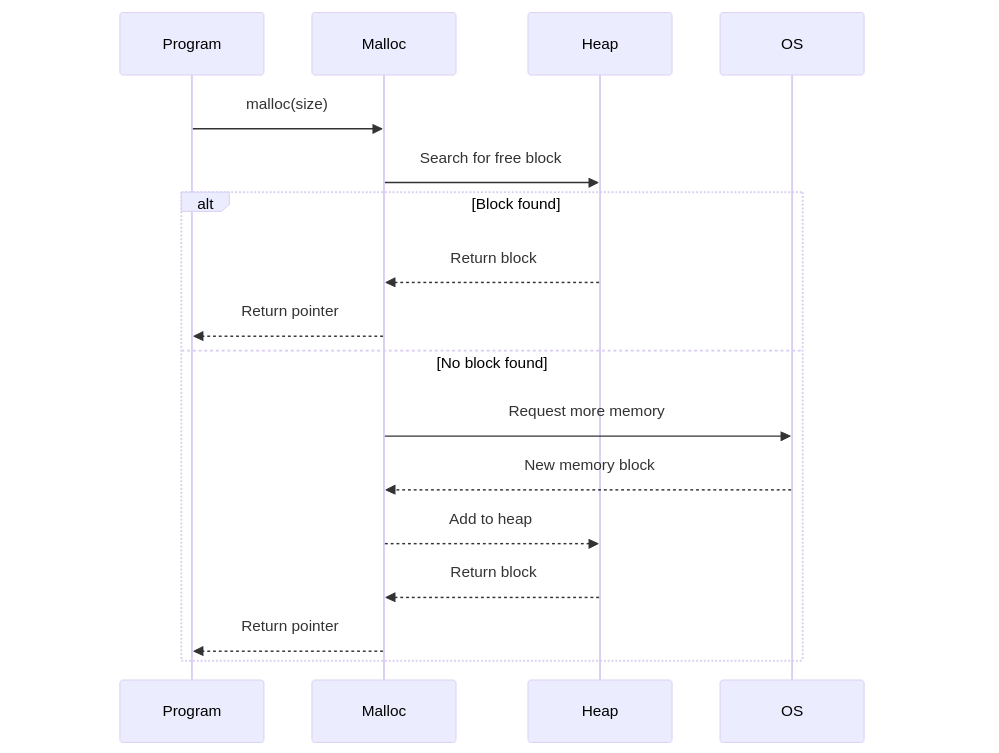Mastering Memory Management with malloc and free in C
Understanding Heap Management, Fragmentation, and Performance in C
The functions malloc and free are the primary tools for dynamic memory management, but their internal workings and impact on the heap are often misunderstood. This blog post explains the internals of these functions, explaining how they manage memory, their effects on the heap, and the implications for program performance.
The Heap: A Dynamic Memory Pool
The heap is a region of memory used for dynamic memory allocation. Unlike the stack, which follows a last-in-first-out (LIFO) order, the heap allows for more flexible memory management. Memory in the heap is allocated and freed in arbitrary order, which can lead to fragmentation if not managed properly.
How malloc Works Internally
When you call malloc(size), the C runtime library searches the heap for a free block of memory that can satisfy the request. The process involves several steps:
Searching for a Free Block: The memory allocator maintains a list of free blocks. It searches this list for a block that is large enough to accommodate the requested size. If a suitable block is found, it is marked as allocated.
Splitting Blocks: If the found block is larger than needed, it may be split into two parts: one to satisfy the allocation request and the other to remain as a free block. This helps in reducing internal fragmentation.
Allocating New Memory: If no suitable free block is found, the allocator requests more memory from the operating system. This is typically done using system calls like
sbrkormmap. The newly allocated memory is then added to the heap.Alignment and Padding:
mallocensures that the allocated memory is properly aligned with the data type being stored. This may involve adding padding bytes, which can lead to internal fragmentation.
How free Works Internally
The free function deallocates memory previously allocated by malloc. The process involves:
Marking the Block as Free: The memory block is marked as free, making it available for future allocations. This involves updating the metadata associated with the block.
Coalescing Free Blocks: To reduce external fragmentation, the allocator may coalesce adjacent free blocks into a single larger block. This helps in satisfying larger allocation requests in the future.
Updating Free Lists: The free block is added to the list of free blocks maintained by the allocator. This list is used by
mallocto find free blocks during allocation.
Impact on the Heap
The use of malloc and free significantly impacts the heap's structure and efficiency:
Fragmentation: Both internal and external fragmentation can occur. Internal fragmentation happens when allocated blocks are larger than needed due to alignment and padding. External fragmentation occurs when free blocks are scattered, making it difficult to allocate large contiguous blocks.
Performance: Frequent allocation and deallocation can lead to performance overhead. The allocator must search for free blocks, split and coalesce blocks, and manage metadata, all of which consume CPU cycles.
Memory Overhead: Each allocated block has associated metadata, such as its size and status (allocated or free). This metadata consumes additional memory, adding to the overhead.
Best Practices for Efficient Memory Management
To mitigate the negative effects of malloc and free on the heap, consider the following best practices:
Minimize Allocations: Reduce the number of dynamic memory allocations by reusing memory blocks where possible.
Use Memory Pools: Implement memory pools for objects of the same size to reduce fragmentation and allocation overhead.
Avoid Memory Leaks: Always ensure that every allocated block is freed when no longer needed. Use tools like Valgrind to detect and fix memory leaks.
Optimize Allocation Sizes: Allocate memory in sizes that minimize internal fragmentation. For example, allocate in powers of two if alignment is a concern.
Conclusion
Understanding the internals of malloc and free is crucial for effective memory management in C. These functions provide powerful capabilities but come with challenges such as fragmentation and performance overhead.
By following best practices and leveraging tools for memory analysis, developers can optimize their use of dynamic memory, leading to more efficient and reliable applications. Mastering these concepts will enable you to harness the full potential of dynamic memory allocation in your C programs.





